References for UV-Visible Spectroscopy
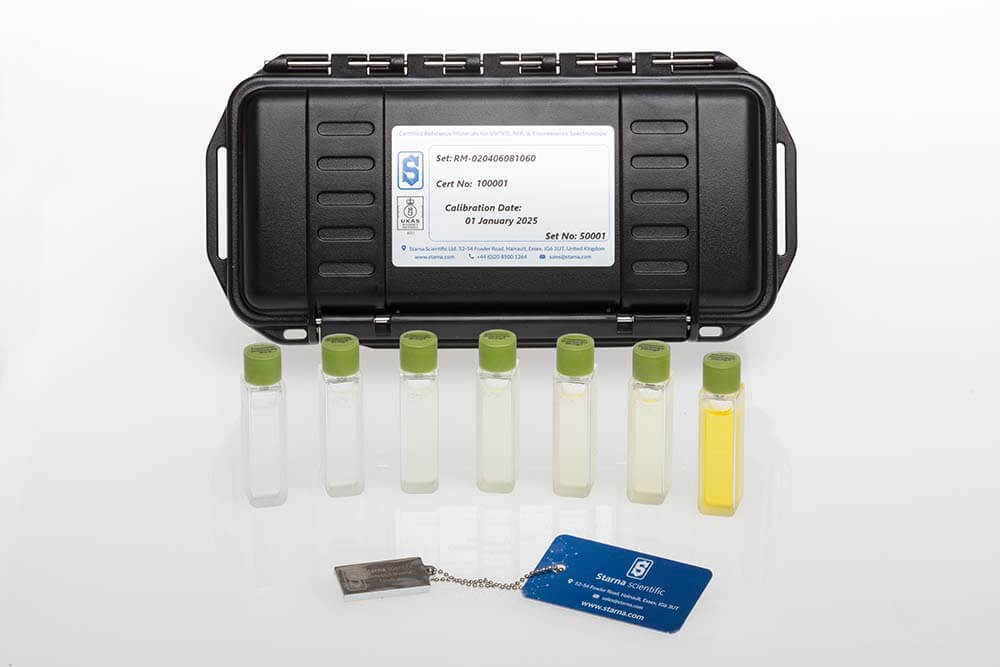
Potassium Dichromate (235 – 430 nm)
Potassium dichromate in 0.001 M perchloric acid, permanently sealed by heat fusion into 10 mm UV-quality quartz cells. Solutions are prepared from solid potassium dichromate, NIST SRM 935a.
The use of potassium dichromate solvated in dilute perchloric acid is an established and well recognised method for the validation of the absorbance scale and linearity of a spectrophotometer in the UV region. When prepared in 0.001 M perchloric acid, potassium dichromate gives a spectral scan containing characteristic peaks at 257 nm and 350 nm, and troughs at 235 nm and 313 nm.
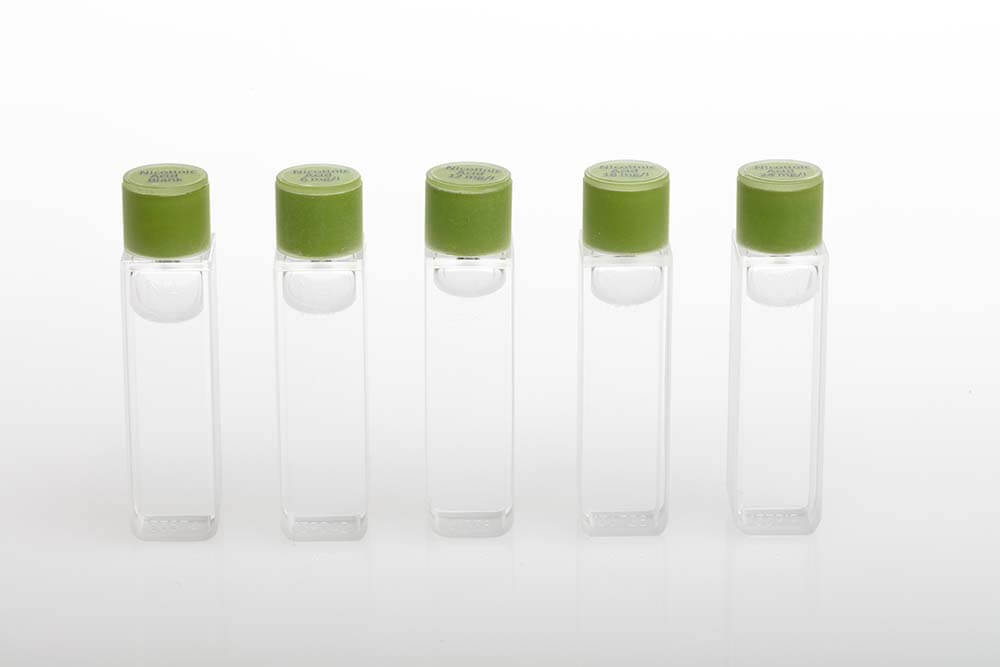
Nicotinic Acid (210 – 260 nm)
Nicotinic acid solutions with concentrations from 6 to 24 mg/l in dilute (0.1 M) hydrochloric acid, sealed in high quality far UV quartz cells. Supplied with a 0.1 M hydrochloric acid blank.
The spectrum of nicotinic acid, when prepared in acid solution, has characteristic peaks at approximately 213 nm and 261 nm. Within the concentration range 6-24 mg/l, if the absorbance scale of a narrow bandwidth (<2 nm) spectrophotometer is linear, the apparent absorbance of a series of concentrations measured at these peaks will be a linear function of concentration.
Solutions are available at higher concentrations giving absorbance values up to 2.4A. Starna do not recommend the use of Nicotinic Acid for linearity measurements above 1.0 A
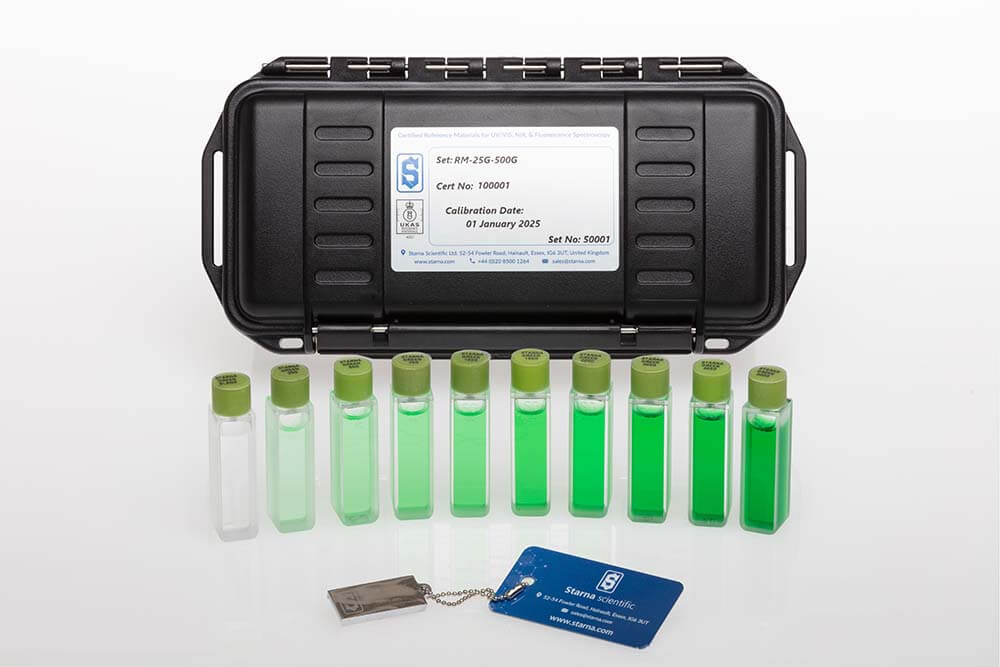
Starna Green (Broadband SBW instruments) (250-650 nm)
Most reference materials available for instrument wavelength qualification are chosen for their well-defined spectra, with sharp absorption bands, and are usually recommended for instruments with spectral bandwidths of 3 nm or less. This is partly because most absorption bands are asymmetric, so the apparent peak wavelength will change with bandwidth and partly because wider bandwidth instruments may be unable to resolve some peaks at all.
The use of aqueous dye solutions, however, is an established and well-recognised method for the validation of the absorbance scale and linearity of a spectrophotometer. Starna Green is a specially formulated dye solution with three broad but well-defined peaks that can be certified for both wavelength and absorbance value in the UV and visible regions, at bandwidths up to 20nm.

Deep UV Reference (190-220 nm)
Qualifying a UV spectrophotometer in the deep UV presents particular problems, both in identifying a suitable reference material and in accommodating the variability in transmittance characteristics of UV grade quartz below 200nm. These problems have been overcome with this novel Reference Material by using innovative design and manufacturing protocols.
The Reference Material consists of a TS8* solution which has distinct absorption/transmission and peak characteristics in the deep UV, supplied together with a solvent blank in an identically matched pair of 10 mm far UV quartz cells. Each liquid is permanently heat-fused sealed into the cell.
The Reference Material is suitable for qualifying UV spectrophotometers in the range 190-230 nm. The reference is certified for absorbance qualification at approximately 191 nm, 209 nm and 226 nm. Nominal absorbance values are 1.2 A, 0.6 A and 1.0 A respectively.
*TS8 is a proprietary matrix with the necessary spectral characteristics and stability to be used as a reference material.
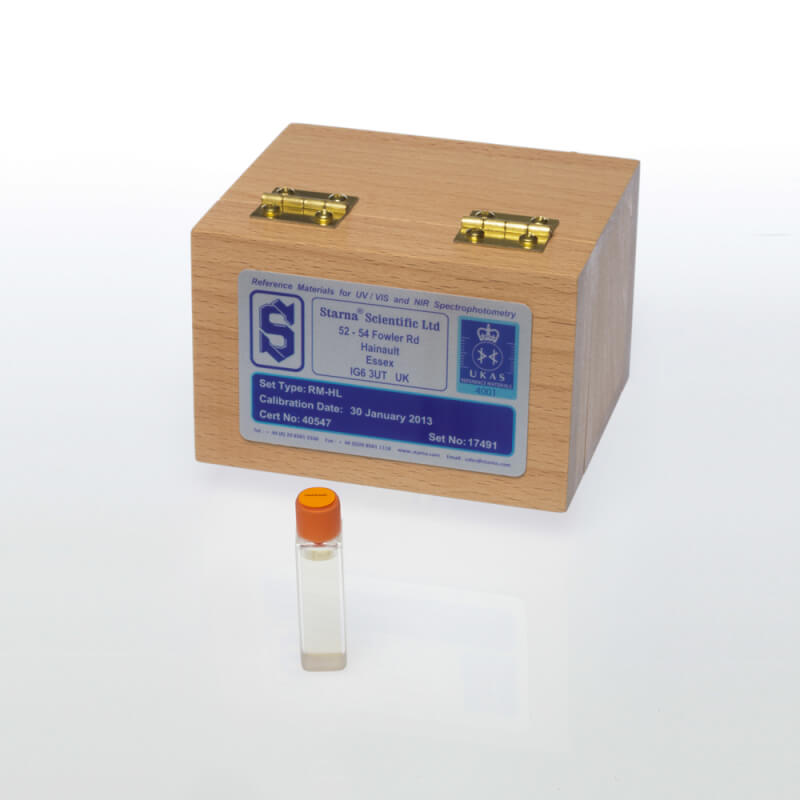
Holmium Oxide Liquid (240-650 nm)
Holmium oxide (4% m/v) in 10% v/v perchloric acid, permanently sealed by heat fusion into a 10 mm far UV quartz cuvette.
The use of holmium oxide solvated in perchloric acid is an established and well recognised method for the validation of the wavelength scale of a spectrophotometer in the UV and visible regions. Aqueous perchloric acid solvent is used as the solvent as the resulting Ho3+aq species is relatively stable to changes in temperature and concentration.
When prepared in perchloric acid, holmium oxide gives a spectral scan containing a series of 14 characteristic andwell-defined peaks covering the wavelength range from 240 to 650 nm.
References for Fluorescence Spectroscopy
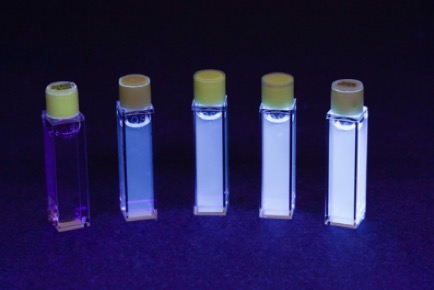
Quinine Sulfate Solution References
10mm far UV quartz fluorometer cuvettes with polished faces at 90° containing Quinine Sulfate solvated in perchloric acid, permanently sealed by heat fusion. The reference can be supplied with or without a perchloric acid blank. It is also available as sets of solutions with concentrations up to 1.0 mg/l for use as a linearity check. Quinine Sulfate Dihydrate in perchloric acid was one of the first reference materials developed for use in fluorescence spectroscopy, and is designated SRM 936a by NIST. The data supplied with the reference is based on its corrected fluorescence emission spectrum using an excitation wavelength of 347.5 nm.
This Reference Material can be used to calibrate the spectral response of a spectrofluorometer over the range 375 nm to 675 nm. It can also, over a limited concentration range, be used as a linearity check.
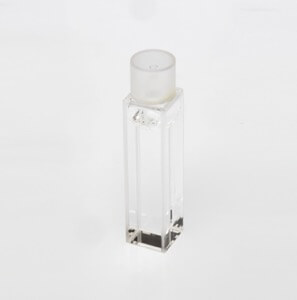
High Purity Water (Raman) Reference
10mm far UV quartz fluorometer cuvette with polished faces at 90°, containing ultra-high purity water, permanently sealed by heat fusion.
Traditionally, the performance of spectrofluorometers has been tested using dilute solutions of known fluorophores such as Quinine Sulfate or Rhodamine to determine spectral response factors. Starna Certified Reference Materials are available for this purpose. To use this approach at or near the detection limit of a high-performance instrument however, is impractical because the necessary sample concentrations are so low that sample preparation becomes difficult and errorprone and there is high potential for sample contamination.
This Reference Material can be used to qualify the Signal to Noise Ratio of a spectrofluorometer near the limit of detection and hence indicate its ultimate sensitivity.
References for Raman Spectroscopy

Cyclohexane Wavelength Reference (380 cm-1 – 3000 cm-1)
Reagent grade cyclohexane, permanently sealed by heat fusion into a 10 mm quartz cuvette.
Compared to atomic emission lines, Raman shift standards offer an easier-to-use alternative for qualifying the wavelength scale of Raman Spectrometers. They are also independent of laser frequency. The Raman shift values for cyclohexane have been accurately measured and it is widely used as a reference material. The permanently sealed cuvette eliminates the hazards associated with handling this volatile,toxic and highly flammable material. Using an excitationwavelength of 514.5 nm, 11 shift values covering a range from 384.1 to 2938.3 cm-1 can be identified.
